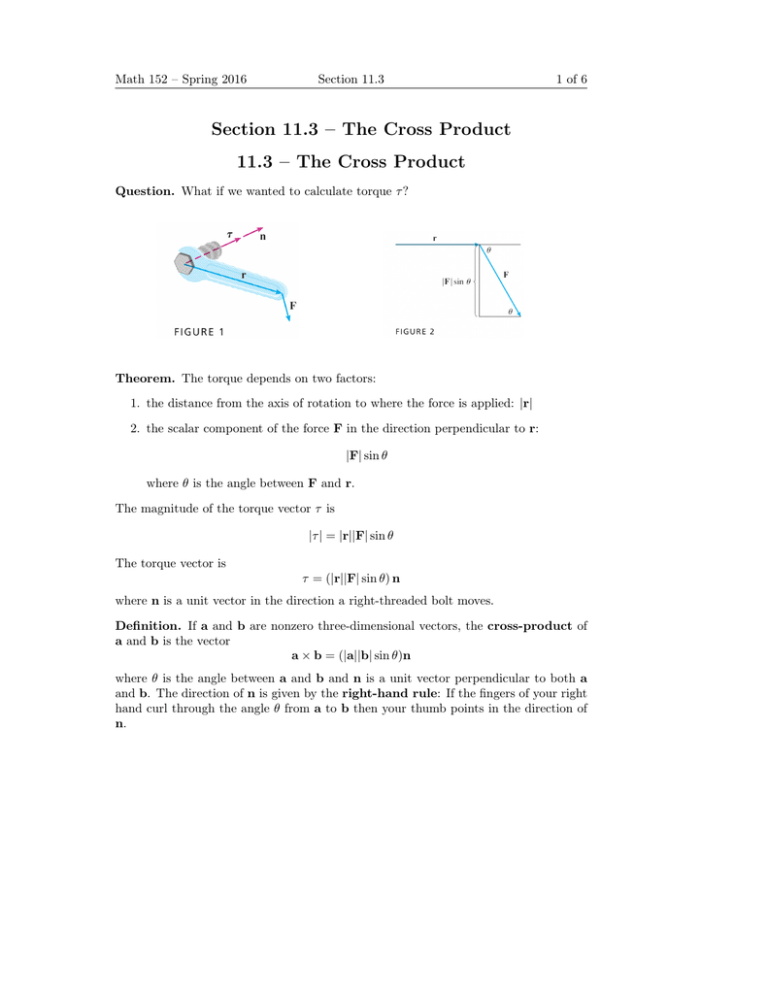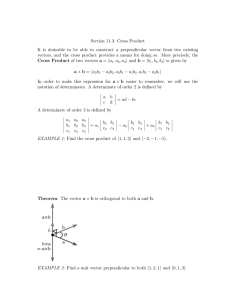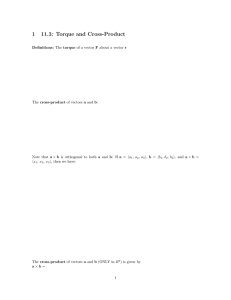Section 11.3 – The Cross Product 11.3 – The Cross Product
advertisement

Math 152 – Spring 2016 Section 11.3 1 of 6 Section 11.3 – The Cross Product 11.3 – The Cross Product Question. What if we wanted to calculate torque τ ? Theorem. The torque depends on two factors: 1. the distance from the axis of rotation to where the force is applied: |r| 2. the scalar component of the force F in the direction perpendicular to r: |F| sin θ where θ is the angle between F and r. The magnitude of the torque vector τ is |τ | = |r||F| sin θ The torque vector is τ = (|r||F| sin θ) n where n is a unit vector in the direction a right-threaded bolt moves. Definition. If a and b are nonzero three-dimensional vectors, the cross-product of a and b is the vector a × b = (|a||b| sin θ)n where θ is the angle between a and b and n is a unit vector perpendicular to both a and b. The direction of n is given by the right-hand rule: If the fingers of your right hand curl through the angle θ from a to b then your thumb points in the direction of n. Math 152 – Spring 2016 Section 11.3 2 of 6 Note. 1. a × b is a vector. 2. a × b is orthogonal to both a and b. → − 3. Two nonzero vectors a and b are parallel if and only if a × b = 0 . 4. Recall, a · b is a scalar, and two nonzero vectors a and b are orthogonal if a · b = 0 Example 1. A bicycle pedal is pushed by a foot with a 60-N force as shown. The shaft of the pedal is 15 cm long. Find the magnitude of the torque about P. Example 2. Find i × j and j × i. Cross Products of Standard Basis Vectors i×j=k j × i = −k i × k = −j k×i=j j×k=i k × j = −i Math 152 – Spring 2016 Section 11.3 3 of 6 Properties. If a, b, and c are vectors and c is a scalar, then 1. a × b = −b × a 2. (ca) × b = c(a × b) = a × (cb) 3. a × (b + c) = a × b + a × c 4. (a + b) × c = a × c + b × c Note. The Cross Product is NOT associative, a × (b × c) 6= (a × b) × c so the order we calculate the cross products DOES matter (unlike with multiplication and addition). Example 3. Are the following vectors equal? (a) i × (i × j) = (b) (i × i) × j = Example 4. Find |u × v| if |u| = 3, |v| = 4, and the angle between the vectors is π 6. Question. How do we calculate the cross product without the angle? How do we find the unit vector n? Theorem. If a = ha1 , a2 , a3 i and b = hb1 , b2 , b3 i, then a × b = ha2 b3 − a3 b2 , a3 b1 − a1 b3 , a1 b2 − a2 b1 i Question. How am I ever going to memorize this formula? Definition. For matrices a determinant of order 2 is defined by a b = ad − bc c d A determinant of order 3 a1 a2 b 1 b2 c c2 1 is defined by using second-order determinants a3 b2 b3 b1 b3 b1 b2 b3 = a1 − a2 + a3 c2 c3 c1 c3 c1 c2 c3 Math 152 – Spring 2016 Section 11.3 4 of 6 Theorem. For the vectors a = ha1 , a2 , a3 i and b = hb1 , b2 , b3 i, we can write their cross-product using the formula: i a × b = a1 b 1 a = 2 b2 k a2 a3 b2 b3 a1 a3 i − b1 b3 j a1 a3 j + b1 b3 a2 k b2 = (a2 b3 − a3 b2 )i − (a1 b3 − a3 b1 )j + (a1 b2 − a2 b1 )k Example 5. Find the cross product a × b for a = h1, −2, 4i, b = h2, 0, −1i Example 6. Find a nonzero vector orthogonal to the plane through the points P (2, 1, 0), Q(−5, 4, 3), and R(1, 3, 1). Example 7. Find two unit vectors orthogonal to both vectors a = i+j and b = i−j+k. Math 152 – Spring 2016 Section 11.3 5 of 6 Theorem. The length of the cross-product a × b is equal to the area of the parallelogram determined by a and b. The order of the vectors in the cross product does not matter. Example 8. Find the length of the parallelogram through points K(1, 0, 3), L(1, 1, 8), M (3, 2, 4), and N (3, 3, 9). Example 9. Find the area of the triangle formed by the three points P (2, 1, 0), Q(−5, 4, 3), and R(1, 3, 1) from Example 6. Definition. The product a · (b × c) is called the scalar triple product of the vectors a, b, and c. The scalar triple product gives a scalar answer. Theorem. The volume of the parallelepiped determined by the vectors a, b, and c is the absolute value of the scalar triple product: V = |a · (b × c)| The vectors can be put into the formula in ANY order since we are taking the absolute value. Math 152 – Spring 2016 Section 11.3 6 of 6 Example 10. Find the volume of the parallelepiped determined by the vectors a = h2, 3, −2i, b = h−2, 3, 4i, and c = h4, −2, 4i. Definition. Three vectors are coplanar if there is a 2-dimensional plane that contains all three vectors. Theorem. Three vectors are coplanar if and only if their scalar triple product is 0. Example 11. Use the scalar triple product to determine if the vectors u = i − 2j + j, v = 2i − j + 4j, and w = i − 5j + 3j are coplanar.




